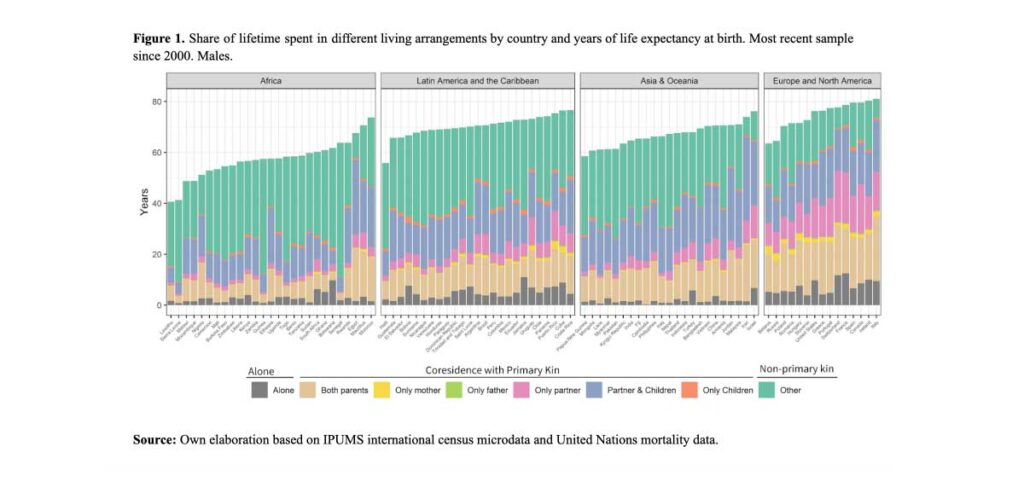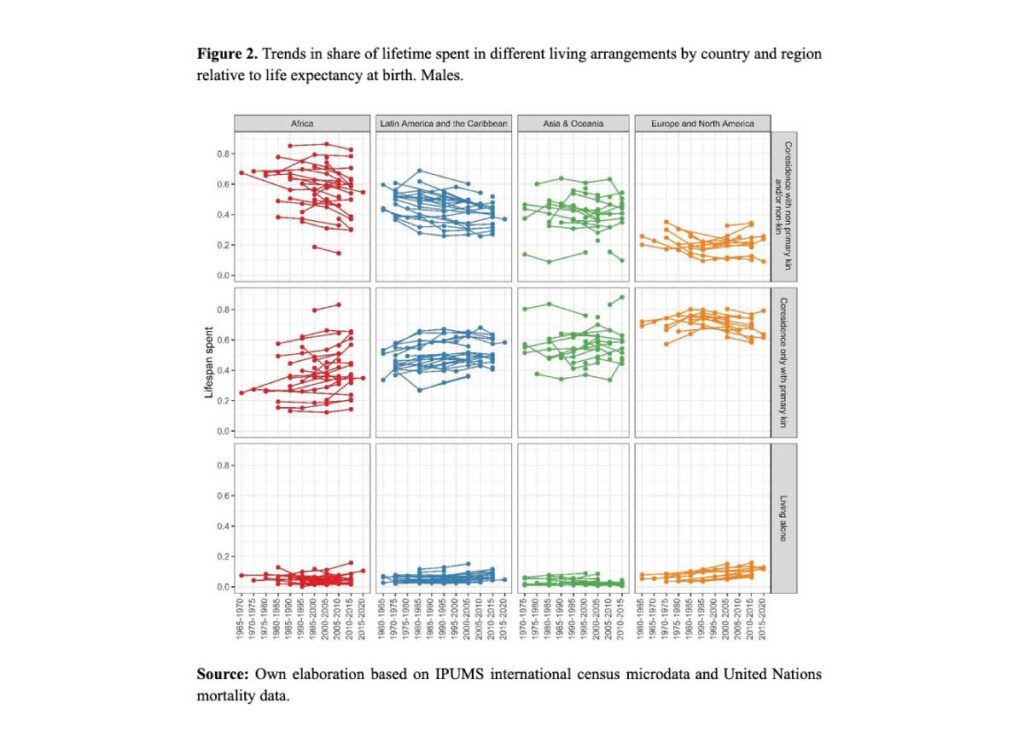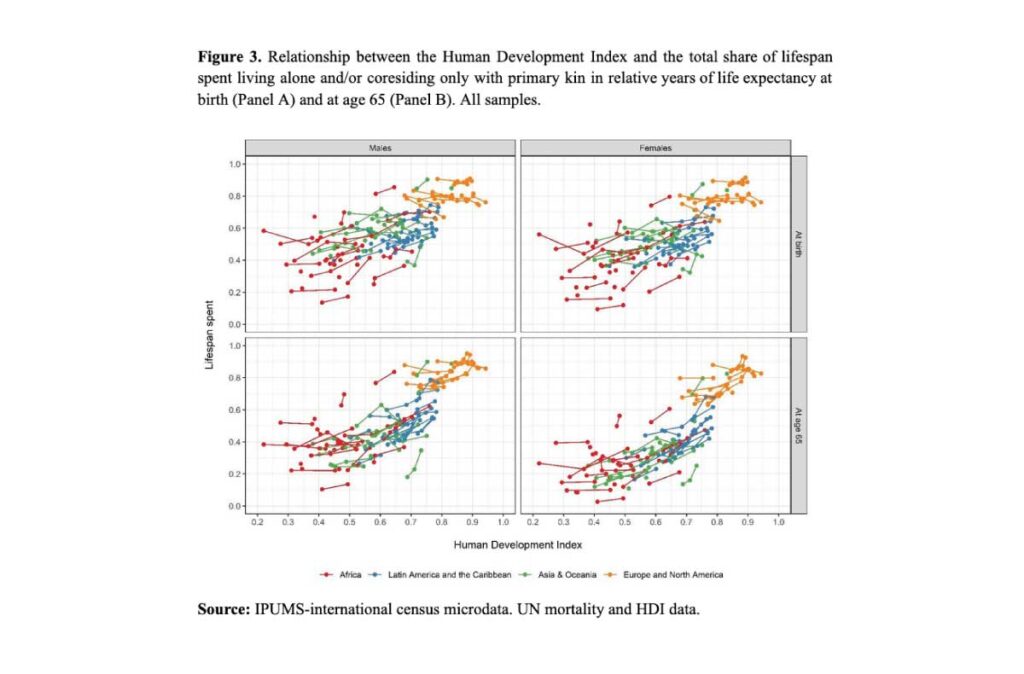Living arrangements have changed over the past five decades, leading to a decline of the extended family, growth of the nuclear family and, more recently, the appearance of living alone as a significant lifestyle option for many. Diversity continues to prevail around the world. These trends, David Reher argues, suggest patterns for the relatively near future.
Introduction
Knowledge of the family and the way it functions is essential for our understanding of contemporary society. Existing debates point to the uniqueness of the nuclear family in the developed West and the role development played in this process. Yet lack of comparable data for much of the world has limited the scope of research on the family around the world. Addressing this issue is now possible thanks to the revolution in census microdata provided within the IPUMS project (Minnesota Population Center 2020).
In a recent publication (Esteve & Reher, 2024), Albert Esteve and I make use of massive amounts of data (from 90 countries and 279 samples) to address key issues related to family organization –specifically to living arrangements and the way they have changed over the past half century. We classified basic living arrangements into three categories for each individual present in the household: living alone, living only with nuclear kin (parents, offspring and/or spouses), and living with at least one non-primary kin (grandparents, grandchildren, aunts, uncles, cousins, etc.) in addition to other primary kin. We estimated exposure rates for every age group and type of living arrangement. Combining these rates for all ages enabled us to generate estimates of the relative share of the life course spent in each type of living arrangement. The results provide a nuanced view of co-residence patterns for societies around the world over the past half century.
Major results
At the start of the twenty-first century there continued to be a wide diversity of family forms around the world. In some regions, people spent a large share of their lifespan living in large families with an abundant presence of non-primary kin and/or non-kin (e.g. many African countries), while in others, people spent most of their lives in households with only nuclear kin (e.g. most developed countries). The results presented in Figure 1 are based on males for the most recent census for each country. Individual country data are arranged by macro region (generally continent) and, within each region, according to the life expectancy in each country. In this way, columns are higher in countries with higher life expectancy. The disparities in the share of the lifespan spent living with non-primary kin (the key to all extended families) are vast, ranging from relatively low in Europe and North America to more than 50 per cent of total life expectancy in most of Africa and in many Latin American and Asian countries. At the outset of the twenty-first century, the world of the family was a diverse one indeed. The predominance of the nuclear family, so important for our understanding of the family around the world, only existed in the developed world, while extended families were predominant elsewhere.

Change over time is shown in Figure 2 (again, only males) where different living arrangements are organized in horizontal panels and world regions are shown vertically. It is important to remember here that everywhere the sum of propensities for the three different living arrangements is, by definition, 1.0 in all countries. This figure shows the changes that have occurred over the past half century, with census dates marked by circles and country trends by lines.

A major result from this figure is that the growth in the prevalence of living arrangements based only on primary kin (nuclear families) around the world over the past half century is especially strong in countries where starting levels were lower. Generally, growth in the prevalence of the nuclear family has been substantial and, by implication, that of the extended family has declined. It is important to underscore the overall diversity of these estimates, both in recent years and in the past. Africa was and is the world region where the presence of non-primary kin was, and continues to be highest, though there have been evident declines. This also fits for Latin America and Asia, yet the prevalence of extended families tends to be lower. The basic pattern of change, however, is very different in the developed world, where from the start the prevalence of nuclear families is much higher than elsewhere. Beginning in the 1990s, however, there is a clear halt to the decrease of extended families, coupled with a modest decline in nuclear families and increases in the shares of people living alone.
Countries with the highest levels of development are invariably ones where the prevalence of coresidence with non-primary kin and the extended family are lowest, yet time trends for individual countries are not always clear (see Figure 3 with results for males and females). If we only use data for elderly adults (>65) the links between development and the share of the lifespan spent living alone and/or with only nuclear kin are clearer.

A brief discussion
Should current trends continue, in the relatively near future we can expect a continued growth of nuclear living arrangements in much of the world. We can also expect, however, slow or negative growth, coupled with a continuing trend towards an incipient decomposition of the components of kinship in societies where living with nuclear kin is highest, caused largely by on-going reductions in the presence of offspring and of parenting couples in nuclear households. Quite possibly this will take place together with increases in the prevalence of either living alone or living in households including persons unrelated by kinship. These trends have important implications for policy, for society, and for the meaning itself of the family and family life in different parts off the world. Rapidly shrinking household size in much of the world provides a relevant backdrop for these important changes in kin-based co-residence (Esteve et al., 2024). In aging societies, the capacity of families to rely on traditional support networks for the health and well-being of their vulnerable members raises significant concerns.
It is often held that development is a major determinant of the prevalence of the nuclear family because it enables family groups to live in small units and, when the need arises, to avail themselves of institutional supports such as day care that tend to be widespread in societies that can afford them. It also brings improvements in health, longer lives and higher education for large segments of the population. Our study provides some support for this premise. It also points to the major role potentially played by fertility and mortality in shaping kin networks themselves and their needs, and invites further research on the emerging subject of the demography of kinship. Where networks are dense in human and social capital, kin available for co-residence are abundant and will be in demand. As these networks shrink, the prevalence of living arrangements based only around primary kin will increase and the presence of non-primary kin in households around the world will tend to decrease. Mortality also plays a role, especially because of its implications for health and longevity as well as the way it affects the number of available kin.
Once again, the timing and pace of the demographic transition emerges as a key factor in explaining the long-term trends of major social indicators. This does not negate the importance of culturally constrained preferences and values for family development over time, but it does appear to be a key marker for the timing and intensity of change. Development is, of course, important, but is not the sole factor. When kin networks shrink to their bare minimum, the realm of conscious choice tends to emerge as a key element in shaping family life. The influence of the second demographic transition on family structures in North America and Europe and, potentially, in many other societies around the world now and in the future, serves as a pertinent example.
Moving a bit further back in time, these findings also suggest that the prevalence of extended family living arrangements in much of the developing world may have peaked in the 1950s or 1960s, when fertility remained exceptionally high and mortality was already in sharp decline in many parts of the world. By contrast, in the developed world, fertility and mortality were already relatively low and, by implication, kin networks were relatively small, nuclear living was the norm, and ideas of change were pervasive. In this part of the world where closely aligned patterns of fertility and mortality together with relatively modest levels of population growth characterized the entire demographic transition, it is likely that kin networks were consistently modest in size and nuclear living was widespread well before the onset of the twentieth century.
A key, albeit surprising, finding of this paper is the evidence it provides of a recent trend reversal currently taking place in much of the most developed world involving large declines in co-residence only with primary kin, major increases in living alone, and modest increases in co-residence with non-primary kin. This trend is likely related to the spreading effects of the second demographic transition, to increasing longevity, to shrinking kin networks and to the increasing difficulties experienced by families in much of the world (Esteve and Reher 2021). Could it constitute the most recent stage of a fundamental pattern of family development over time outlined, at least in part, in this paper? Possibly. While speculative, this viewpoint warrants further investigation.
References
Esteve, Albert, David S. Reher. 2021.”Rising Global Levels of Intergenerational Coresidence Among Young Adults”. Population and Development Review 47 (3): 691-717. https://doi.org/10.1111/padr.12427.
Esteve, Albert and David S. Reher. 2024. “Trends in Living Arrangements around the World”. Population and Development Review. https://doi.org/10.1111/padr.12603.
Esteve, Albert, Maria Pohl, Federica Becca, Huifen Fang, Juan Galeano, Joan García-Román, David Reher, Rita Trias-Prats, and Anna Turu. 2004. “A global perspective on household size and composition, 1970–2020.” Genus – Journal of Population Sciences, 80 (2), pp 1-22. https://doi.org/10.1186/s41118-024-00211-6


